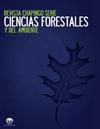墨西哥瓦哈卡海岸亚落叶森林的供水和径流质量
IF 0.6
4区 农林科学
Q3 Agricultural and Biological Sciences
Revista Chapingo Serie Ciencias Forestales Y Del Ambiente
Pub Date : 2021-12-01
DOI:10.5154/r.rchscfa.2020.10.063
引用次数: 0
摘要
简介:在瓦哈卡沿海地区,土地利用的变化和咖啡加工产生的废物排放可能会影响城市供水的数量和质量。目的:确定墨西哥瓦哈卡州Pluma Hidalgo和Santa María Huatulco微流域含水层污染水平并估算地表水径流量。材料与方法:对2019年雨季7个供水点进行分析。测定了以下理化参数:pH、总溶解固形物、电导率、硬度、总固体、氯化物和化学需氧量(COD)。地表径流用Raws和Prevert方法估算。结果和讨论。水体在供人类使用的允许范围内。Chacalapilla泉水为中等硬度(85 mg CaCO3∙L-1),而7个水体的COD均超过允许限量(40 ~ 200 mg∙L-1);因此,水在污染分类范围内,不适合人类饮用。地表径流值表明植被覆盖处于中等保护状态;盖度越高的地区,径流系数越低。理化参数表明,Pluma Hidalgo和Santa María Huatulco的水适合人类使用,但不适合饮用本文章由计算机程序翻译,如有差异,请以英文原文为准。
Water supply and water runoff quality in the sub deciduous forest of the Coast of Oaxaca, Mexico
Introduction: Land use change and waste discharge from coffee processing may be affecting quantity and quality of water supplying urban areas in the coastal region of Oaxaca.Objective: To determine the level of contamination of aquifers and estimate surface water runoff in micro-watersheds of Pluma Hidalgo and Santa María Huatulco in Oaxaca, Mexico.Materials and methods: Seven water supply points were analyzed during the rainy season of 2019. The following physicochemical parameters were determined: pH, total dissolved solids, electrical conductivity, hardness, total solids, chlorides, and chemical oxygen demand (COD). Surface runoff was estimated using the Raws and Prevert methods.Results and discussion. Water bodies are within the permissible limits for human use. The Chacalapilla spring was classified as moderately hard (85 mg CaCO3∙L-1), while the seven water bodies exceeded the permissible limit for COD (40 to 200 mg∙L-1); therefore, water is in a contaminated classification range and is not suitable for human consumption. Surface runoff values suggest a medium conservation condition of vegetation cover; areas with higher cover recorded lower runoff coefficients.Conclusions. The physicochemical parameters indicated that water from Pluma Hidalgo and Santa María Huatulco is suitable for human use, but not for drinking
求助全文
通过发布文献求助,成功后即可免费获取论文全文。
去求助
来源期刊
CiteScore
1.20
自引率
16.70%
发文量
0
审稿时长
>12 weeks
期刊介绍:
The Revista Chapingo Serie Ciencias Forestales y del Ambiente (RCHSCFA) is a scientific journal that aims to raise awareness of high-quality research products related to forest, arid, temperate and tropical environments in the world. Since its foundation in 1994, the RCHSCFA has served as a space for scientific dissemination and discussion at a national and international level among academics, researchers, undergraduate and graduate students, forest managers and public/private entities that are interested in the forest environment.
All content published in the journal first goes through a strict triple-blind review process and is published in the following formats: Scientific Articles, Review Articles, Methodologies, Technical or Technological Notes.

 求助内容:
求助内容: 应助结果提醒方式:
应助结果提醒方式:


